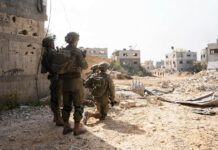
“I’d like to sleep through the rest of this war and wake up when it’s over. After all, I could read about what happened.” — from the diary of Rywka Lipszyc, Feb. 12, 1944.
For the global community of Holocaust scholars and educators, the 80th anniversary of the Nazi pogrom against Germany’s Jews commonly known as “Kristallnacht” — which falls today and Shabbos — could scarcely come at a more pertinent moment.
Since the violent far-right rally in Charlottesville, Virginia, in August 2017, Americans have become transfixed by the growing brazenness of this country’s white supremacists. In the last month alone, the murderous consequences of this hatred have been on graphic display — first in the Oct. 24 slaying of two African-Americans in a Kentucky grocery store by a gunman who reportedly tried to enter a black community church moments earlier, and then the Oct. 27 massacre of 11 Jewish worshipers at Pittsburgh’s Tree of Life Synagogue by a neo-Nazi assailant, marking the worst antisemitic atrocity in the history of the US.
Over in Europe, antisemitism is more in the frame now than at any other time since the Nazi era. From the antisemitic murders of two elderly French Jewish women — Sarah Halimi in 2017 and Mireille Knoll this year — to the unresolved crisis over antisemitism at all levels of the British Labour Party, to the bitter disputes in Eastern European countries on the topic of wartime collaboration with the Nazis, scarcely a day passes without discussion or reflection on whether there is a future for Jews on the continent. And in the Middle East, Holocaust denial, crude antisemitism and comparisons between Israel and Nazi Germany remain a staple of the region’s media, as well as a core theme of the Iranian regime’s propaganda.
Against this background, Holocaust educators see little alternative to doubling their efforts in their quest to demonstrate where antisemitism and racism can lead. One trusted tool in that regard has been the growing archive of personal testimonies, letters, diaries, paintings and sketches that were produced by Holocaust victims before they perished — documents that humanize their experiences by providing first-person insights into their thoughts, their worries and their daily lives.
Among the most moving of the textual accounts is the diary of Rywka Lipszyc, a Jewish teenager whose ordeal during the Holocaust took her from the Lodz Ghetto in Poland to both the Auschwitz and Bergen-Belsen Nazi concentration camps. Gravely ill, Rywka is assumed to have died in a hospital in Germany in 1945, shortly after the Allied victory in World War II.
When The Algemeiner spoke last month with Dr. Anita Friedman — a leading San Francisco-based Holocaust educator whose unsparing efforts resulted in the publication of Rywka’s Diary in 2014 — the focus of the discussion was on the diary’s significance in understanding how the Nazi persecution of the Jews evolved from the Kristallnacht (“Night of Broken Glass”) pogrom to a full-scale program of extermination. More than one hundred Jews were slaughtered during the night of Nazi violence on Nov. 9 and 10, 1938, with 30,000 Jewish men deported to concentration camps, and hundreds of synagogues, homes, Jewish-owned stores and hospitals incinerated across Germany and Nazi-controlled Austria. Alongside the 1935 Nuremberg Laws that effectively classified Jews as subhuman, Kristallnacht was a critical milestone in the coming Holocaust that took Rywka Lipszyc and millions like her.
But with the Pittsburgh synagogue massacre of Oct. 27, Friedman’s latest initiative to promote the diary and its lessons has taken on an unexpected urgency. “The attack on the Tree of Life Synagogue in Pittsburgh showed the world that the antisemitic violence we commonly associate with the past — with pogroms, persecution and the Holocaust — is alive and well today,” Friedman told The Algemeiner in an email on Wednesday. “It is more important than ever to educate new generations through firsthand accounts like ‘Rykwa’s Diary’ about the devastation wrought by antisemitism, so that we can commit to ending it.”
Currently, the diary is a centerpiece of a multimedia exhibit at the Museum of Jewish Heritage in New York City, which runs until January. Assembled in cooperation with the Galicia Jewish Museum in Krakow, Poland, “The Girl in the Diary” allows visitors to read from a selection of Rywka’s entries — which began on Oct. 3, 1943 and ended abruptly on Apr. 12, 1944. After New York, the exhibition about Rywka will travel to the Jewish Museum in Milwaukee, and after that to the Contemporary Jewish Museum in San Francisco.
Much of the diary’s searing drama stems from the circumstances of its discovery. Plucked from the ruins of the Auschwitz crematoria by a Soviet Army doctor, Zinaida Berezovskaya in 1945, the diary arrived in San Francisco fifty years later in the hands of Berezovskaya’s granddaughter, who had emigrated to California.
The original copy of Rywka’s diary is now housed at Yad Vashem, Israel’s official Holocaust memorial in Jerusalem. But an English language version, edited by Friedman in 2014 and containing all 112 pages of the diary, has served to introduce a new generation to the horrors of the Holocaust.
For Friedman, Rywka’s unshakable commitment to the Jewish faith is one of the elements that makes her diary special. “She was a girl who was very religious,” Friedman explained. “Her formal education stopped at the age of 11, when Hitler invaded Poland, but at the age of 14, she was capable of writing a beautifully-crafted diary. The way she grappled with deep questions of theology and faith makes it very unusual.”
An entry of Feb. 1 , 1944 gives a sense of Rywka’s literary talents, with her psalm-like plea to God to come to her aid. “O, God help me lift myself up, I can’t do it on my own!” she wrote. “Don’t let me flinch before hardship and put me back on my feet!…My God! I have such longing…” But she also had a 14-year-old’s penchant, even under extraordinary hardship, for observations about her family, her friends and her life in the ghetto suffused with gentle humor and feeling. There are passages of great melancholy too: “It’s the second day of the holidays,” she wrote on Apr. 11, 1944, during Passover. “How was the Seder? How could it be?! Oh, Daddy’s absence made our life miserable. The Seder without Daddy, but without not only Daddy, without men at all…”
Friedman’s hope is that Rywka’s voice will “inspire current generations to be morally courageous and socially responsible.”
“I wish she were alive to know that we are all so sorry we were not in a position to protect you in your time of urgent need,” she reflected. “But we are continuing your legacy 70 years later.”
While there has been concern that interest in the Holocaust is fading as it recedes in time, Friedman argued that the reverse is happening. She singled out Germany’s government for “setting the standard for moral clarity” in Holocaust education, but added that there were encouraging trends in other countries too — including Poland, where political life for much of this year has been dominated by legislation that outlawed discussion of Polish collusion with the Nazi occupying authorities. Nonetheless, Friedman said, last year Poland added Rywka’s Diary to its Holocaust-education curriculum. “This increased interest in understanding what happened during the Holocaust and for patterns of genocide currently is an encouraging trend,” Friedman said, pointing to the recent genocides in the Sudanese region of Darfur and against the Yazidi minority in Iraq as crimes that can be further understood through the lens of the Holocaust.
Now published in 15 languages, with a film currently in production in Poland, Friedman presents Rywka’s Diary as the unique perspective of a religious Jewish girl in Nazi-occupied Poland on the tribulations of the Jewish people over 3,000 years. She also holds up the diary as a warning against trivializing Nazism and its legacy — a point to bear in mind, perhaps, as the world prepares to commemorate the atrocity of Kristallnacht.
“Labeling anything that’s bad ‘Nazi’ or ‘Naziesque’ reveals a lack of understanding,’” Friedman said, when asked about the present profusion of Nazi analogies on social media and in national politics. “So to me, that’s also an opportunity to do more Holocaust education.”
(c) The Algemeiner Journal
{Matzav.com}












These firsthand stories of the horrific suffering by innocent children are indescribably heartbreaking. Even worse is knowing there were no happy endings for Rywka Lipszyc, Anne Frank, or the millions of other innocents murdered by the Nazis and their all-too-willing helpers, ym”s.